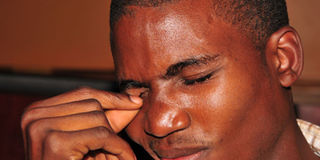how to deal with it :eye twitching

Photo credit: Michael kakumirizi
Eyelid twitch or eyelid spasm is an involuntary contraction of the eyelid muscles. It may repeatedly close or repeatedly close and reopen. Once it starts, it continues on-and-off for a few days. In most cases, you may not even notice when the twitch has stopped.
The cause of eyelid twitch may be due to age, fatigue, stress, too much light absorption in the eyes and excess consumption of alcohol. Sometimes the reason for the twitch cannot be known and it may last longer giving you discomfort, thus the eyelids may close completely.
Symptoms to this twitching are strong sensitivity to light, blurry vision, itching and irritation of the cornea and repeated uncontrollable spasms of the upper lid.
Although eyelid twitching may disappear without treatment, Dr Joseph Masajjage, an optometrist at Boss Optical Centre, recommends getting more sleep and lubricating eyes with eye drops.
If persistent, a cloth soaked with cold water can be covered on the eyes for at least 10 minutes or use a cool cap that gently massages the eyes to make them relaxed.
Dr Masajjage strongly warns against plucking eyelashes to relieve the itching of the eyelid. Once a lash is removed, a pore is left and this increases the risk of infection because we normally rub our eyes with dirty fingers.
If the twitch does not go within a week after the treatment, completely closes the eyelid, involves other parts of your face or have a swelling or discharge from the eye, then you need to see an opthamologist.
This is because permanent eye injury is possible though rare depending on the level of the twitch. At this level it is severe and you need special care from the opthamologist.
Other eyelid disorders may include abnormal blinking, eyelid cancer and eyelids that droop.
Drooping may be caused by aging, diabetes, stroke, brain tumour and nerve injury. There is no need to worry about drooping unless your vision is blocked.




